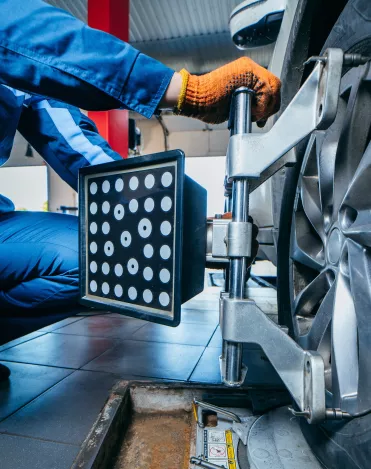Tyre and wheel alignment for all vehicle
Wheel alignment, also known as tracking, is an affordable service that can help you save money. Wheel alignment is part of your car maintenance and must be checked regularly to avoid risks on the road. Read how to identify a bad wheel alignment and why checking and maintaining the alignment of your tyres is key for your safety and your budget!

What is vehicle wheel alignment?
Wheel alignment consists of adjusting the angle of the wheels to make them parallel to each other and perpendicular to the ground. This operation is intended to prevent too much friction or the premature wear of tyres or suspension.
Wheel alignment is the adjustment of three elements: camber, toe, and caster.
- Camber adjustment: seen from the front of the vehicle, the specialist adjusts the inward or outward angles of the tyre.
- Toe adjustment: seen from above, the angle identifies the exact direction the tyres are pointed compared to the centerline of the vehicle.
- Caster adjustment: seen from the side, this angle identifies the forward or backward slope of a line drawn through the upper and lower steering pivot points.
Point S expertise in tyre alignment for motorcycles, trucks, and agricultural vehicles
All Point S centres carry out tyre services. Our experts are well-trained in new technologies and have the best equipment. They are qualified to work on any type of vehicle, from cars to trucks or agricultural vehicles.
What’s the benefits of wheel alignment?
A good alignment will bring you many benefits in terms of comfort, efficiency, and safety:
- It will help to reduce the maintenance budget of your car. With a good adjustment, your tyres will benefit from better rolling resistance.
- It reduces fuel consumption. When your 4 tyres are well aligned, it reduces friction on the road requiring less energy for the same driving distance.
- It optimizes the lifetime of your tyres.
- It protects some mechanical parts of the vehicle. Parts of your car that show abnormal wear may be the result of a bad alignment.
- 4 wheels aligned improve maneuverability and car control, which is a huge safety factor when driving in poor weather conditions. Moreover, it provides a much more pleasant driving experience.
- Your vehicle will emit less CO2, which is obviously better for the environment!
3 indicators of poor wheel alignment
How do you know if you need an alignment? Check out our 3 key indicators:
- Your tyres wear out irregularly
- The steering of your vehicle is modified in a straight line: When safe to do so, you can try to release the steering wheel for one second. If you notice that the direction of your car is drifting to the left or the right, this may be a sign that a wheel alignment is needed.
- The curved trajectory changes
When to check your alignment?
It is recommended to align the wheels of your vehicle once a year or every 10,000 miles. However, an anomaly in alignment can appear anytime during the lifetime of the tyre because of hitting a kerb or driving over a pothole. If you notice the appearance of one of the three indicators above or just need a check for peace of mind, we advise that you visit a Point S expert for advice.
When was the last time you checked your tyre alignment? Find your local Point S branch and ask for expert advice.

